
Fonda is a village in and the county seat of Montgomery County, New York, United States. The population was 795 at the 2010 census. The village is named after Douw Fonda, a Dutch-American settler who was killed and scalped in 1780, during a Mohawk raid in the Revolutionary War, when the tribe was allied with the British.

Glen is a town in Montgomery County, New York, United States. The population was 2,507 at the 2010 census. The town was named after Jacob Glen, an early landowner.
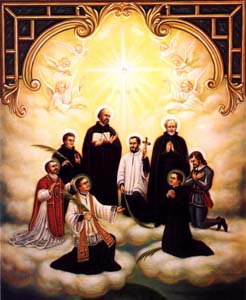
The Canadian Martyrs, also known as the North American Martyrs, were eight Jesuit missionaries from Sainte-Marie among the Hurons. They were ritually tortured and killed on various dates in the mid-17th century in Canada, in what is now southern Ontario, and in upstate New York, during the warfare between the Iroquioan tribes the Mohawk and the Huron. They have subsequently been canonized and venerated as martyrs by the Catholic Church.
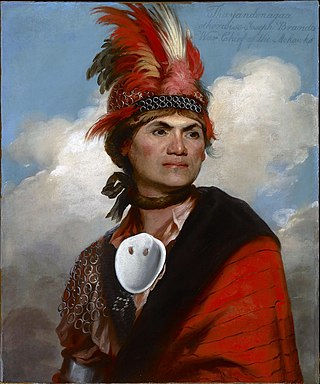
The Mohawk people are the most easterly section of the Haudenosaunee, or Iroquois Confederacy. They are an Iroquoian-speaking Indigenous people of North America, with communities in southeastern Canada and northern New York State, primarily around Lake Ontario and the St. Lawrence River. As one of the five original members of the Iroquois League, the Mohawk are known as the Keepers of the Eastern Door – the traditional guardians of the Iroquois Confederation against invasions from the east.

Kateri Tekakwitha, given the name Tekakwitha, baptized as Catherine, and informally known as Lily of the Mohawks, is a Catholic saint and virgin who was an Algonquin–Mohawk. Born in the Mohawk village of Ossernenon, in present-day New York State, she contracted smallpox in an epidemic; her family died and her face was scarred. She converted to Catholicism at age nineteen. She took a vow of perpetual virginity, left her village, and moved for the remaining five years of her life to the Jesuit mission village of Kahnawake, just south of Montreal. She was beatified in 1980 by Pope John Paul II and canonized by Pope Benedict XVI at Saint Peter's Basilica on 21 October 2012.
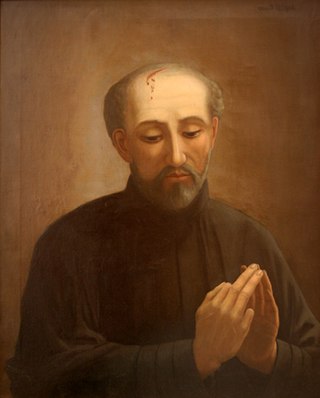
Isaac Jogues, SJ was a French missionary and martyr who traveled and worked among the Iroquois, Huron, and other Native populations in North America. He was the first European to name Lake George, calling it Lac du Saint Sacrement. In 1646, Jogues was martyred by the Mohawk at their village of Ossernenon, near the Mohawk River.

Sainte-Marie among the Hurons was a French Jesuit settlement in Huronia or Wendake, the land of the Wendat, near modern Midland, Ontario, from 1639 to 1649. It was the first European settlement in what is now the province of Ontario. Eight missionaries from Sainte-Marie were martyred, and were canonized by the Catholic Church in 1930. Sainte-Marie Among the Hurons was designated a National Historic Site of Canada in 1920. A reconstruction of the mission now operates as a living museum.

René Goupil, S.J., was a French Jesuit lay missionary who became a lay brother of the Society of Jesus shortly before his death. He was the first of the eight North American Martyrs of the Roman Catholic Church to receive the crown of martyrdom and the first canonized Catholic martyr in North America.

Jean de Lalande, SJ was a Jesuit missionary at Sainte-Marie among the Hurons and one of the eight North American Martyrs. He was killed at the Mohawk village of Ossernenon after being captured by warriors.

Gabriel Lalemant was a French Jesuit missionary in New France beginning in 1646. Caught up in warfare between the Huron and nations of the Iroquois Confederacy, he was killed in St. Ignace by Mohawk warriors and is one of the eight Canadian Martyrs.
Pierre Cholenec was a French Jesuit missionary and biographer in New France. He ministered to First Nations in present-day Canada, particularly at the village of Kahnawake south of Montreal. He served as superior of the Jesuit residence in Montréal. He is known for writing multiple biographies about Kateri Tekakwitha which contributed to her canonization in 2012 by Pope Benedict XVI.
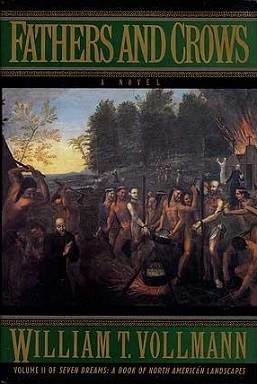
Fathers and Crows is a 1992 historical novel by the American author William T. Vollmann. It is the second book in the seven-book series Seven Dreams: A Book of North American Landscapes.

The National Shrine of the North American Martyrs, also known as the Shrine of Our Lady of Martyrs, is a Roman Catholic shrine in Auriesville, New York dedicated to the three Jesuit missionaries who were martyred at the Mohawk Indian village of Ossernenon in 1642 and 1646.

Caughnawaga Indian Village Site is an archaeological site located just west of Fonda in Montgomery County, New York. It is the location of a 17th-century Mohawk nation village. One of the original Five Nations of the Iroquois League, or Haudenosaunee, the Mohawk lived west of Albany and occupied much of the Mohawk Valley. Other Iroquois nations were located west of them and south of the Great Lakes.
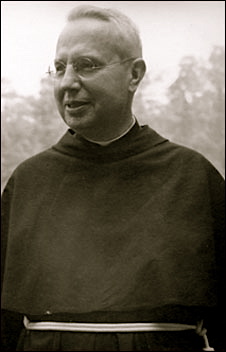
Rev. Thomas Grassmann, OFM Conv, was a Conventual Franciscan friar, historian and archaeologist of Colonial New York, who discovered the site of the Mohawk American Village of Caughnawaga near Fonda, New York.

Camp Ondessonk is an outdoor, Catholic residential youth camp run by the Diocese of Belleville. It is located in the Shawnee National Forest of Southern Illinois, near Ozark, Illinois. The mission of the camp is "Exceptional outdoor and spiritual adventures empowering kids of all ages." Camp Ondessonk is accredited by the American Camp Association.
Caughnawaga is a former town in then Tryon County, later Montgomery County, New York, United States.
Claude Chauchetière was a French Jesuit missionary, priest, biographer, and painter. Claude Chauchetière is well known for his published work Annual Narrative of the Mission of the Sault from Its Foundation Until the Year 1686 which detailed his time in New France as a Jesuit missionary. For most of his mission work he was placed in the village of Kahnawake where he encountered Kateri Tekakwitha, an Algonquin-Mohawk Jesuit convert, an encounter that immensely impacted his spiritual life. Later on Chauchetière would also actively work to get Kateri Tekakwitha canonized as a saint.
Eustache Ahatsistari was a Huron warrior. He is famous for his conversion to Catholicism and his death at the hands of the Iroquois. Ahatsistari was captured alongside St. Isaac Jogues and several other Huron prisoners in 1642 and was tortured and executed. He is notable for his conversion to Christianity and his role in the lives of early French missionaries in the Americas.















